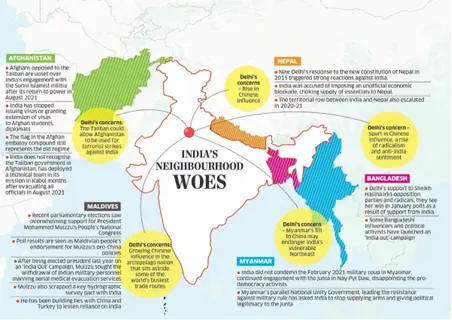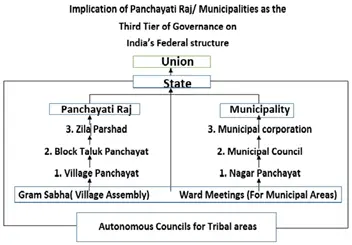Wednesday, 4th September 2024
Digital Agriculture Mission
Context:
- Recently, The Union Cabinet has approved the Rs 2,817-crore Digital Agriculture Mission for the creation of Digital Public Infrastructure (DPI) in the farm sector.
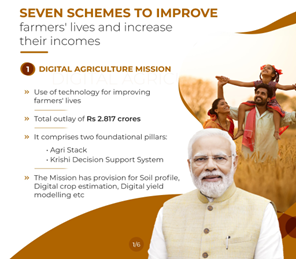
Digital Agri Mission:
- Objective:
- The Digital Agri Mission is designed to promote and expedite the adoption of digital technologies such as Artificial Intelligence (AI), blockchain, remote sensing, robotics, and drones in agriculture.
- Key Features:
- Farmers Registry:
- Purpose: Establishment of a nationwide registry that assigns a unique ID to every farmer.
- Current Implementation: States like Uttar Pradesh and Maharashtra have already initiated the generation of these IDs.
- Significance: The unique farmer ID will enable access to various government schemes, such as PM-Kisan and Fasal Bima Yojana, as well as financial services like farm loans and insurance.
- Crop Sown Registry:
- Purpose: Development of a registry documenting the crops sown by farmers on their land.
- Significance: This registry will facilitate improved planning and crop production estimation.
- India Digital Ecosystem of Agriculture (IDEA):
- Framework: The Department is finalising the creation of an "Agristack," a digital foundation for developing innovative agri-focused solutions.
- Unified Farmers Service Interface (UFSI):
- Purpose: Creation of a unified platform offering farmers access to services such as weather updates, market prices, and agro-advisory.
- Funding to States for New Technology (NeGPA):
- Implementation: Financial assistance provided to states and union territories for projects integrating advanced technologies like AI, blockchain, IoT, and robotics.
- Revamping Mahalanobis National Crop Forecast Centre (MNCFC):
- Objective: Enhancement of crop forecasting capabilities through technological advancements.
- Soil Health, Fertility, and Profile Mapping:
- Objective: Utilisation of digital tools to evaluate soil health and fertility.
- Timeline:
- The Mission will be implemented over the next two years, concluding in 2025-26.
- Pilot Projects:
- Pilot initiatives have been launched in six districts: Farrukhabad (Uttar Pradesh), Beed (Maharashtra), Gandhinagar (Gujarat), Fatehgarh Sahib (Punjab), and Virudhunagar (Tamil Nadu).
- Farmers Registry:
- Benefits:
- Inclusivity and Accessibility: The Aadhaar system has provided a unique identity to over 1.3 billion Indians, enabling them to access various government services and subsidies efficiently.
- Economic Growth: The Unified Payments Interface (UPI) system has transformed financial transactions in India, simplifying digital payments for small businesses and individuals, thus boosting economic growth.
- Efficiency and Transparency: The Direct Benefit Transfer (DBT) system has significantly minimised leakages in welfare schemes by directly ensuring that subsidies reach the intended beneficiaries, enhancing transparency.
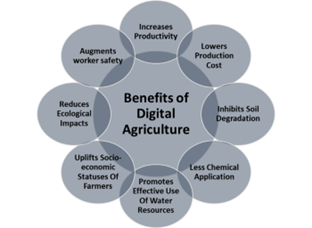
Issues with Agri-Tech in India:
- Limited Digital Literacy: A significant number of farmers lack the necessary skills and access to effectively utilise Agri-Tech solutions.
- High Upfront Costs: The substantial initial investment required for Agri-Tech solutions poses a barrier, particularly for small-scale farmers.
- Fragmented Land Holdings: The prevalence of small and fragmented land holdings complicates the implementation of large-scale mechanisation.
- Limited Infrastructure: Inadequate access to essential infrastructure such as electricity and internet services hampers the widespread adoption of Agri-Tech.
- Inadequate Government Policies: Inconsistencies and poor implementation of government policies reduce the effectiveness of Agri-Tech initiatives.
- Lack of Collaboration: Limited cooperation among farmers, the private sector, and the government restricts the development of effective Agri-Tech solutions.
- Limited Market Access: Challenges in accessing markets and obtaining market information hinders the adoption of Agri-Tech innovations.
- Drone Regulation Issues: Privacy concerns arise due to the advanced sensors and cameras equipped on drones, affecting their regulation and usage in agriculture.
Digital Public Infrastructure in the Agriculture Sector;
- Objective:
- The Digital Agriculture Mission seeks to establish a comprehensive Digital Public Infrastructure (DPI) in the agriculture sector, analogous to successful e-governance initiatives in India like Aadhaar, DigiLocker, UPI, and electronic health records.
- AgriStack:
- Foundation: AgriStack forms the basic IT infrastructure under the Mission, consisting of three primary Agri-sector registries or databases:
- Farmers’ Registry:
Farmers will be assigned a digital identity, termed 'Farmer ID,' akin to Aadhaar, linked to records such as land ownership, livestock, crops, demographics, and benefits availed.- Target: The government plans to issue digital identities to 11 crore farmers, with coverage expected to reach 6 crores by 2024-25, 3 crores by 2025-26, and the remaining 2 crore by 2026-27.
- Crop Sown Registry:
This registry will document the crops sown by farmers, leveraging data from Digital Crop Surveys conducted each season. - Geo-referenced Village Maps:
These maps will connect geographic land records with their physical locations.
- Farmers’ Registry:
- Foundation: AgriStack forms the basic IT infrastructure under the Mission, consisting of three primary Agri-sector registries or databases:
- Krishi Decision Support System (DSS):
- Functionality: Krishi DSS is a geospatial platform that integrates remote sensing data on crops, soil, weather, and water resources, enabling crop mapping, drought and flood monitoring, yield assessments, and crop insurance claim processing.
- Soil Profile Maps:
- Scope: The Mission aims to prepare detailed Soil Profile Maps (on a 1:10,000 scale) for approximately 142 million hectares of agricultural land, with 29 million hectares already completed.
- Digital General Crop Estimation Survey (DGCES):
- Objective:
- DGCES aims to enhance the accuracy of agricultural production estimates by integrating digitally captured data on crop-sown areas with yield.
- Remote-sensing data, thereby improving the efficiency and transparency of schemes like MSP-based procurement, crop insurance, and credit-linked crop loans.
- Objective:
- Funding:
- The Digital Agriculture Mission has an allocated budget of Rs 2,817 crore, with Rs 1,940 crore provided by the Centre and the remainder by states and Union Territories.
- Implementation Timeline:
- Initially planned for launch in 2021-22, the Mission was delayed due to the Covid-19 pandemic.
- It is now set to be implemented nationwide by 2025-26, as part of the Agriculture Ministry's 100-day activities under the newly formed government.
- The Mission, announced in the Union Budgets of 2023-24 and 2024-25, aims to cover farmers and their lands within three years.
- A digital crop survey for the Kharif season will be conducted in 2024, covering 400 districts and including details of 6 crore farmers and their lands.
|
UPSC Civil Services Examination, Previous Year Questions (PYQs) Prelims Q:1 In India, the term “Public Key Infrastructure” is used in the context of: [2020]
Answer: A
Q:2 Consider the following statements: (2017)
Which of the above statements is/are correct?
Ans: (b) |
Source: IE
The Disaster Management (Amendment) Bill is Knotty
Why in the news?
- The Disaster Management (Amendment) Bill, introduced in the Lok Sabha on August 1, 2024, aims to improve India's disaster management policy.
- The Bill seeks to amend the Disaster Management Act, 2005, due to rising climate-induced disasters.
- The proposed amendments raise concerns about increased centralization and potential erosion of cooperative federalism in India.
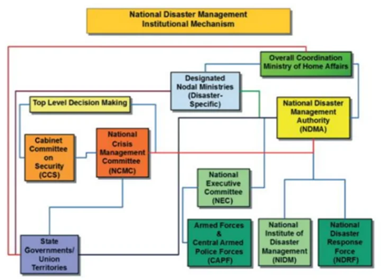
Key Provisions of The Disaster Management Amendment Bill 2024:
- Urban Disaster Management Authority: Establishes an Urban Disaster Management Authority for state capitals and major cities with Municipal Corporations, excluding Delhi and Chandigarh.
- Disaster Database: Proposes a national and state-level disaster database to include disaster assessments, fund allocation details, expenditure, preparedness, mitigation plans, and risk registers as determined by the Central government.
- Decentralised Disaster Plans: Empowers the National Disaster Management Authority (NDMA) and State Disaster Management Authorities (SDMA) to prepare disaster plans at the national and state levels, respectively, replacing the previous role of the National Executive Committee and State Executive Committees.
- Stock-taking of Disaster Risks: Grants NDMA the authority to periodically assess disaster risks, including emerging risks from extreme climate events and other factors.
- Statutory Status: Provides statutory status to pre-existing organisations like the National Crisis Management Committee and the High-Level Committee.
- State Response Force: Mandates the creation of a State Disaster Response Force by state governments.
- Section 60A: Empowers Central and State governments to direct actions or inactions to reduce disaster impacts, with penalties up to ₹10,000 for non-compliance.
- Clarity and Convergence: Allows NDMA to appoint experts and consultants, defines roles of Authorities and Committees, and seeks to enhance the efficiency of NDMA and SDMAs.
- Immunity: Grants immunity to officials involved in disaster management from legal proceedings while performing their functions.
- Jurisdiction: Limits jurisdiction to the Supreme Court and High Courts for suits related to functions under the Act.
An Analysis of Gaps in Financial Devolution in Disaster Management:
- A Missed Opportunity:
- Significance: Financial devolution is critical for enabling state and local governments to respond to disasters efficiently.
- Bill’s Aim: The Disaster Management (Amendment) Bill, 2024, seeks to enhance the roles of the National Disaster Management Authority (NDMA) and State Disaster Management Authorities (SDMAs).
- Critical Shortcoming: The Bill does not address historical financial constraints at state and local levels that impede disaster response.
- Centralised Financial Structure:
- Current Framework: The Disaster Management Act, 2005, centralises disaster management funds through the National Disaster Response Fund (NDRF) and the State Disaster Response Fund (SDRF).
- Challenges: Centralised control often results in delays in fund disbursal, particularly during severe disasters.
- Examples: States like Tamil Nadu and Karnataka have faced prolonged delays in receiving NDRF funds, impacting immediate relief and recovery efforts.
- Urban Disaster Management Authority:
- Proposal: The Bill introduces Urban Disaster Management Authorities for state capitals and cities with municipal corporations.
- Financial Shortfall: This initiative lacks sufficient financial backing, which is necessary for effective disaster management in urban areas.
- Need for Resources: Urban areas require substantial financial resources for preparedness, response, and recovery due to dense populations and critical infrastructure.
- Dilution of the National Disaster Response Fund:
- Issue: The Bill dilutes specific references to the purposes of the National Disaster Response Fund (NDRF), creating ambiguity in fund allocation.
- Potential Impact: This could lead to increased centralization of financial decision-making, with discretionary control remaining with the central government.
- Concerns: The lack of clarity may result in fund allocation influenced by political factors rather than the severity of disasters.
- Restricted Definition of 'Disaster':
- Current Definition: The Disaster Management Act, 2005, and the proposed Bill limit the definition of 'disaster' to events like cyclones, floods, and earthquakes.
- Omission: The definition does not include emerging climate-induced disasters, such as heatwaves.
- Global Trends: The global consensus recognizes heatwaves as climate-related disasters, yet India’s framework excludes them, despite their increasing frequency and severity.
Way Forward:
- A Need for Cooperative Federalism:
- Power Dynamics: The Bill raises concerns about the centralization of power, affecting the balance between central and state governments.
- Constructive Dialogue: The focus should shift from blame to collaborative efforts for effective disaster management.
- Empower States: True cooperative federalism requires rethinking roles and empowering states to lead disaster management.
- Financial Inclusion and Autonomy:
- Importance: Financial preparedness is crucial for effective disaster response.
- Bill’s Limitations: The Bill does not improve financial autonomy for states or address past response failures.
- Example: The delayed response in Wayanad, Kerala, highlights the need for a more decentralised approach.
Conclusion:
While the Disaster Management (Amendment) Bill, 2024, is a step toward strengthening disaster management, it does not fully address critical issues such as financial decentralisation, clarity in fund allocation, and the inclusion of emerging climate-induced disasters. Revising the framework to focus on decentralisation, financial autonomy, and an inclusive disaster definition is essential for building a more resilient and effective disaster management system in India.
|
UPSC Civil Services Examination PYQ Mains
Q:1 Discuss the recent measures initiated in disaster management by the Government of India departing from the earlier reactive approach. (2020) Q:2 Disaster preparedness is the first step in any disaster management process. Explain how hazard zonation mapping will help disaster mitigation in the case of landslides. (2019) Q:3 Describe various measures taken in India for Disaster Risk Reduction (DRR) before and after signing ‘Sendai Framework for DRR (2015-2030)’. How is this framework different from ‘Hyogo Framework for Action, 2005’? (2018) Q:4 How important are vulnerability and risk assessment for pre-disaster management? As an administrator, what are key areas that you would focus on in a Disaster Management System? (2013) |
Source: TH
Chip assembly plant in Gujarat
Why in the news?
- The Union Cabinet, chaired by Prime Minister Narendra Modi, has approved the proposal by Kaynes Semicon to establish a semiconductor unit in Gujarat with an investment of ₹3,300 crore.
- This marks the fifth semiconductor unit and the fourth assembly unit to receive Cabinet approval under the India Semiconductor Mission (ISM).
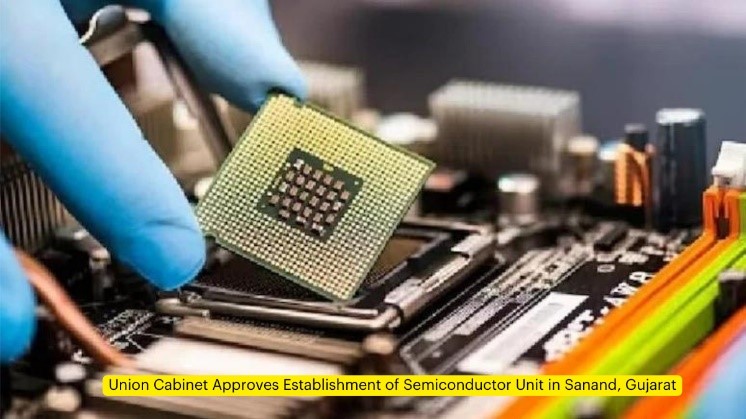
About the India Semiconductor Mission (ISM):
- About:
- The India Semiconductor Mission (ISM) is a specialised and independent Business Division within the Digital India Corporation.
- It is dedicated to establishing a robust semiconductor and display ecosystem, with the objective of positioning India as a global hub for electronics manufacturing and design.
- Mandate:
- ISM possesses full administrative and financial powers, responsible for catalysing the semiconductor ecosystem in India, including manufacturing, packaging, and design.
- The mission is supported by an advisory board comprising leading global experts in the semiconductor field.
- Role as Nodal Agency:
- ISM functions as the nodal agency for the schemes approved under the Semicon India Programme.
- Semicon India Programme:
- Launch: The ISM was launched in 2021 with a financial outlay of Rs. 76,000 crores under the Ministry of Electronics and IT (MeitY), Government of India.
- Objective: It is part of a comprehensive program aimed at developing a sustainable semiconductor and display ecosystem in the country.
- Support: The programme provides financial support to companies investing in the semiconductor, display manufacturing, and design ecosystem.
- Indigenous IP Generation: It promotes and facilitates the generation of Indigenous Intellectual Property (IP) and encourages the Transfer of Technologies (ToT).
- Key Schemes Under the Programme:
- Scheme for setting up Semiconductor Fabs in India.
- Scheme for setting up Display Fabs in India.
- Scheme for setting up Compound Semiconductors/Silicon Photonics/Sensors Fab and Semiconductor Assembly, Testing, Marking and Packaging (ATMP)/OSAT facilities in India.
- Design Linked Incentive (DLI) Scheme
Key Highlights of Chip assembly plant:
- Capacity: The plant will have a capacity of producing 60 lakh chips per day.
- Applications: The chips manufactured will be used across various sectors, including industrial, automotive, electric vehicles, consumer electronics, telecom, and mobile phones.
- Strategic Significance: This move is a significant step in India's ambitions to become a major semiconductor hub, akin to the United States, Taiwan, and South Korea.
Semiconductor Manufacturing in India:
- Need for Domestic Manufacturing:
- Foundation of Modern Electronics: Semiconductors and displays are critical to modern electronics, powering everything from computers and smartphones to car brake sensors.
- Reducing Import Dependency: India currently relies entirely on imports to meet its semiconductor demand, which is expected to reach USD 100 billion by 2025.
- Supply Chain Disruption: The COVID-19 pandemic highlighted the vulnerabilities of relying on external sources for semiconductors.
- Geopolitical Significance: Trusted sources of semiconductors are crucial for national security, especially concerning the security of critical information infrastructure.
- Government Initiatives:
- India Semiconductor Mission (ISM): Launched in 2022, ISM aims to establish a robust semiconductor ecosystem in India. It operates independently under the Digital India Corporation, with an advisory board of global experts.
- Semicon India Programme: Approved in 2021 with a budget of ₹76,000 crore, this program offers incentives to companies in semiconductor-related sectors, promoting sustainable development in this field.
- Design Linked Incentive (DLI) Scheme: Supports 100 domestic semiconductor design companies in developing Integrated Circuits (ICs), Chipsets, and System on Chips (SoCs).
- Modified Scheme for Setting up Semiconductor Fabs: Provides 50% fiscal support for setting up semiconductor fabs in India as part of the Semicon India program.
- Fiscal Support: The Government has committed ₹2,30,000 crore (USD 30 billion) to position India as a global electronics manufacturing hub, with semiconductors as the cornerstone.
- Chips to Startup (C2S) Programme: Aims to train 85,000 engineers in Electronic System Design and Manufacturing (ESDM) over five years.
- India’s Ambitions:
- India is attracting foreign investments in the semiconductor industry, with significant projects like an $11 billion fabrication plant by Tata Electronics in partnership with Taiwan’s Power chip, and chip assembly plants by Tatas, US-based Micron Technology, and Murugappa Group’s CG Power with Japan’s Renesas.
- Proposals like a ₹78,000-crore fabrication plant by Israel’s Tower Semiconductor and a ₹4,000-crore assembly plant by Zoho underscore India’s growing ambitions to establish itself as a major semiconductor hub.
|
UPSC Civil Services Examination, Previous Year Question (PYQ) Prelims: Q:1 Which one of the following laser types is used in a laser printer? (2008)
Ans: (c) |
Source: HT
NIAB Working to Decode Genetic Blueprints
Why in the news?
- Recently, The National Institute of Animal Biotechnology (NIAB) is working to decode the genetic blueprints for conservation of indigenous cattle breeds using Next Generation Sequencing (NGS) data and genotyping technology.

National Institute of Animal Biotechnology (NIAB):
- About:
- The National Institute of Animal Biotechnology (NIAB) is a premier research institution.
- Established under the Department of Biotechnology, Ministry of Science and Technology.
- Located in Hyderabad.
- Research Focus:
- Genetics and Genomics: Investigates genetic makeup to improve livestock breeding.
- Vaccine Development: Works on creating innovative vaccines for disease prevention.
- Diagnostics: Develops tools for early disease detection in animals.
- Reproductive Biotechnology: Advances reproductive technologies to boost animal productivity.
- Mission:
- Addressing Livestock Sector Challenges: Tackles issues in India's livestock sector, essential for the economy and rural livelihoods.
- Enhancing Animal Products: Improves quality and quantity of milk, meat, and eggs.
- Disease Management and Welfare: Focuses on better disease management and overall animal welfare.
- Capacity Building: Offers training programs for students and professionals in animal biotechnology.
BioE3 Policy
- About:
- The BioE3 Policy stands for "Bioenergy, Bioeconomy, and Bioproducts for Environment and Employment."
- Recently launched by the Government of India.
- Aims to promote sustainable development and boost economic growth through the bioeconomy sector.
- Key Objectives:
- Promote Bioenergy: Increase production and utilisation of bioenergy from sources like biofuels, biogas, and biomass.
- Boost Bioeconomy: Encourage development and commercialization of bioproducts such as bioplastics and biochemicals.
- Environmental Sustainability: Promote the use of renewable biological resources, reduce reliance on non-renewable materials, and mitigate environmental degradation.
- Employment Generation: Create jobs in the bioeconomy sector, especially in rural areas, by supporting innovation and research in bio-based industries.
- Strategic Components:
- Research and Development (R&D): Increase R&D in bio-based technologies and processes.
- Infrastructure Development: Build infrastructure for bio-refineries, bioproduct manufacturing units, and bioenergy plants.
- Public-Private Partnerships (PPP): Foster collaboration between government, private sector, academia, and research institutions.
- Regulatory Support: Streamline regulations, offer tax benefits, and provide subsidies to attract investment and encourage growth in the bioeconomy.
- NIAB’s Role in BioE3:
- Genetic Blueprint Decoding: Uses Next Generation Sequencing (NGS) and genotyping technologies for conservation of indigenous cattle breeds.
- Bio-Scaffold Production: Produces natural and 3D printed bio-scaffolds for tissue repair, cell/drug delivery, and bio-banking.
- Biomarkers Development: Develops biomarkers for assessing susceptibility and resistance to TB in cattle.
- Nutritional Stress Assessment: Creates biomarkers for early assessment of nutritional stress-induced negative energy balance affecting cattle productivity and fertility.
Source: TH
RBI to Launch the Unified Lending Interface (ULI)
Why in the news?
- Recently, The Reserve Bank of India (RBI) will soon launch the Unified Lending Interface (ULI), a technology platform designed to facilitate seamless credit, akin to how Unified Payment Interface (UPI) transformed retail payments.
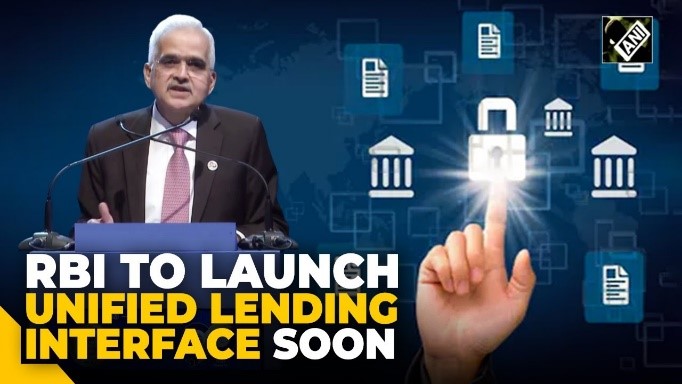
Background in which the Idea of Unified Lending Interface (ULI) Developed:
- Digital Public Infrastructure (DPI): India has advanced rapidly in digitalization, embracing DPI to foster innovative solutions across financial activities.
- Participants: Banks, NBFCs (Non-Banking Financial Companies), fintech companies, and start-ups are encouraged to create solutions in:
- Payments
- Credit
- Other financial services
- Participants: Banks, NBFCs (Non-Banking Financial Companies), fintech companies, and start-ups are encouraged to create solutions in:
- Challenges in Digital Credit Delivery:
- Data Fragmentation: Credit appraisal data is dispersed across various entities, including:
- Central and State governments
- Account aggregators
- Banks
- Credit information companies
- Digital identity authorities
- Hindrance to Frictionless Lending: The separation of data systems impedes seamless and timely rule-based lending.
- Data Fragmentation: Credit appraisal data is dispersed across various entities, including:
- Pilot Project:
- Kisan Credit Card (KCC) Loans: A pilot for digitising KCC loans under ₹1.6 lakh started in 2022.
- Encouraging Results: The pilot facilitated doorstep loan disbursement with minimal paperwork.
- RBI's Initiative:
- Public Tech Platform for Frictionless Credit: Announced by RBI in 2023, this initiative is now known as the Unified Lending Interface (ULI).
What is Unified Lending Interface (ULI)?
- About:
- The Unified Lending Interface (ULI) is a technology platform developed by the Reserve Bank of India (RBI) to enable seamless and consent-based flow of digital information from various data providers to lenders, including state land records.
- Objectives:
- Reduce Credit Appraisal Time: Aims to streamline the credit appraisal process, particularly for smaller and rural borrowers.
- Enhance Efficiency: Improves the lending process by reducing costs, speeding up disbursement, and scaling operations.
- Working:
- Standardised APIs: ULI uses common APIs for a ‘plug and play’ approach, allowing digital access to diverse information sources.
- Example:
- For a dairy farmer applying for a loan, ULI can provide data from a milk cooperative on cash flows, land ownership from state records, and financial insights from farming patterns.
- This allows lenders to quickly assess the applicant’s income and credit eligibility, enabling rapid loan approval and disbursement.
- Significance:
- Simplify Integrations: Reduces complexity by digitising access to both financial and non-financial data from various sources.
- Meet Unmet Credit Demand: Addresses the significant credit needs in sectors like agriculture and MSMEs.
- Support Tenant Farmers: Enables tenant farmers to access credit based on fund usage rather than land ownership.
- Enhance Digital Infrastructure: Complements the JAM (Jan Dhan, Aadhar, and Mobile) and UPI systems, marking a significant advancement in India's digital infrastructure.
Other Platforms Facilitating Lending in India:
- Public Credit Registry (PCR):
- Function: A central database that aggregates comprehensive credit information of borrowers.
- Purpose: Assists lenders in assessing creditworthiness and reducing information asymmetry in the credit market.
- Account Aggregator (AA) Framework:
- Function: A consent-based platform regulated by the RBI.
- Purpose: Enables customers to share financial information across institutions, streamlining access for lenders and facilitating faster, informed lending decisions.
- Credit Information Companies (CICs):
- Function: Organisations such as CIBIL, Equifax, and Experian collect and maintain credit information on individuals and businesses.
- Purpose: Provides credit reports and scores that assist lenders in evaluating credit risk.
- Trade Receivables Discounting System (TReDS):
- Function: An electronic platform for MSMEs to auction their trade receivables.
- Purpose: Allows MSMEs to access financing by selling their receivables at competitive rates.
- Peer-to-Peer (P2P) Lending Platforms:
- Function: Online platforms like Faircent and Lendbox facilitate direct lending and borrowing between individuals.
- Purpose: Provides an alternative lending mechanism outside traditional banking channels.
|
UPSC Civil Services Examination Previous Year Question (PYQ) Prelims Q:1 Which of the following phrases defines the nature of the ‘Hundi’ generally referred to in the sources of the post-Harsha period? (2020)
Ans: (c)
Q:2 Consider the following statements: (2020)
Which of the statements given above is/are correct?
Ans: (b) |
Source: TH
Saora Tribe
Why in the news?
- Recently, Odisha has become the only state to provide such rights to the highest number of particularly vulnerable tribal groups (PVTGs) Saora tribals of Gajapati district.
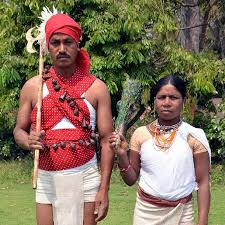
About the Saora Tribe:
- Ancient Origins: The Saora tribe is one of the ancient tribes of Odisha, with references in the epics Ramayana and Mahabharata.
- Nomenclature: The tribe is known by various names, including Savaras, Sabaras, Saura, and Sora.
- Geographical Distribution: While Odisha is their primary homeland, small populations of the Saora tribe are also found in Andhra Pradesh, Jharkhand, Madhya Pradesh, and Assam.
- Language: The Saoras speak their native language, Sora, a Munda language. They are among the few tribes in India with a script for their language, known as Sorang Sompeng.
- Racial Affinity: The Saoras exhibit Proto Australoid physical characteristics, common among the aborigines of Central and Southern India.
- Religion: The Saoras follow a complex religion, worshipping numerous gods and spirits, believed to be the supreme controllers of their daily lives.
- Cultural Practices: They have distinctive art forms, religious customs, and a fading tattooing tradition known as ‘Tantangbo’.
- Economic Classes: The Saoras are divided into two economic classes:
- Plains Saoras (Sudha Saora): Engage in wet cultivation, wage earning, and firewood selling.
- Hill Saoras (Lanjia Saora): Practise shifting and terraced cultivation on hill slopes.
- Settlement Patterns: Saora villages lack a uniform settlement pattern, with houses scattered and megaliths erected nearby to honour deceased kin. Village guardian deities, like Kitungsum, are placed at the entrance.
- Housing: A typical Saora house is a rectangular, one-roomed thatched dwelling with stone and mud walls, a low roof, and a high plinth front verandah. The walls are painted with red earth.
|
UPSC Civil Services Examination PYQ Prelims Q:1 Consider the following statements about Particularly Vulnerable Tribal Groups (PVTGs) in India: (2019)
Which of the statements given above are correct?
Answer: C
Mains Q:1 Given the diversities among the tribal communities in India, in which specific contexts should they be considered as a single category? (2022) Q:2 Why are the tribals in India referred to as ‘the Scheduled Tribes’? Indicate the major provisions enshrined in the Constitution of India for their upliftment. (2016) |
Source: NI
Colombo Security Conclave (CSC)
Why in the news?
- Recently, member states of the Colombo Security Conclave (CSC) signed the Charter and the MoU for the establishment of the CSC Secretariat in Colombo.
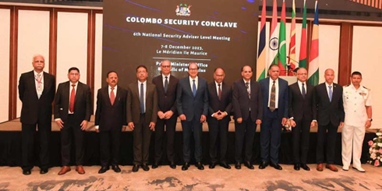
About the Colombo Security Conclave (CSC):
- Formation and Evolution:
- The Colombo Security Conclave (CSC) was established in 2011 as a trilateral maritime security group comprising India, Sri Lanka, and the Maldives.
- Mauritius was welcomed as the fourth member during the fifth meeting of national security advisers, while Bangladesh and Seychelles attended as observers and have been invited to join the group.
- Envisaged Goals: At its fifth meeting, the CSC identified key areas of cooperation to enhance regional security across five pillars:
- Maritime Safety and Security
- Countering Terrorism and Radicalization
- Combating Trafficking and Transnational Organized Crime
- Cyber Security, Protection of Critical Infrastructure, and Technology
- Humanitarian Assistance and Disaster Relief
- Strategic Significance: The CSC is viewed as a platform for India to extend its outreach to the Indian Ocean, emphasising regional cooperation and shared security objectives.
- Countering China's Influence: The CSC aims to curb China's growing influence in the strategically important Indian Ocean region and to reduce its presence in member countries.
- Maritime Security Importance: With a coastline of nearly 7,500 km and strategically located islands, India's maritime security is a priority, and the CSC plays a crucial role in this regard.
- Alignment with SAGAR Vision: The CSC aligns with India’s "SAGAR: Security and Growth for All in the Region" vision and complements India's membership in the QUAD grouping.
- Emerging Sub-Regionalism: The collaboration of six Indian Ocean region countries highlights the development of sub-regionalism on a common maritime and security platform, which holds significance in a broader global context.
- Associated Challenges:
- Domestic Politics: The CSC remains susceptible to domestic political changes within member-states, as demonstrated by the Maldives' absence from a recent meeting.
- Chinese Influence: Despite being democracies, member-states may leverage nationalist and pro-China stances for domestic and external advantages, especially as the Indo-Pacific region gains strategic importance.
- Emerging Sub-Regionalism: The alignment of six Indian Ocean region countries within the CSC indicates the emergence of sub-regionalism on a unified maritime and security platform.
- Way Forward:
- Regional Cooperation: There is a pressing need for collaboration in the IOR due to increasing security concerns and uncertainties.
- Strategic Vision: The CSC is more likely to succeed if it maintains a unified strategic vision without being overshadowed by growing Chinese influence.
- India's Role: To minimise friction with its neighbours, India should recognize that the IOR is evolving into a global common area
|
UPSC Civil Services Examination, Previous Year Questions (PYQs) Prelims Q:1 Consider the following in respect of Indian Ocean Naval Symposium (IONS): (2017)
Which of the above statements is/are correct?
Ans: (b) |
Source: TOI
Law Commission of India
Why in the news?
- Recently, The President of India Droupadi murmu sanctioned the formation of the 23rd Law Commission for a three-year term.
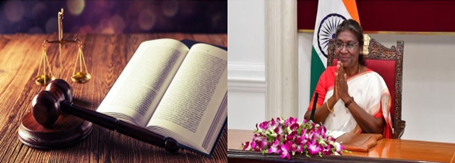
About the Law Commission of India:
- Nature and Constitution:
- The Law Commission of India is a non-statutory body constituted by a notification from the Government of India, Ministry of Law & Justice.
- It is formed with specific terms of reference to conduct research in the field of law and to make recommendations to the Government through reports based on these terms of reference.
- The Commission functions as an advisory body to the Ministry of Law and Justice.
- Historical Background:
- The first Law Commission in pre-independence India was established in 1834 by the British Government under the Charter Act of 1833, chaired by Lord Macaulay.
- The first Law Commission of independent India was established in 1955, under the chairmanship of M. C. Setalvad, the former Attorney General for India.
- Law Commissions have since been reconstituted every three years through executive orders, with the current (22nd) Law Commission chaired by Justice Ritu Raj Awasthi.
- Creation of the Law Commission:
- A new Law Commission is created by the Union government through a resolution after the expiry of the previous commission.
- Following the resolution, and with the President's assent, the government appoints the chairperson for the new commission.
- Functioning:
- The Commission undertakes projects based on references from the Central Government, the Supreme Court, and High Courts.
- It may also initiate studies on specific subjects suo moto, depending on the significance of the matter.
- The Commission’s legal work is supported by law officers from the Indian Legal Service, while administrative support is provided by officers from the Central Secretariat Service.
- The Commission actively welcomes suggestions from individuals, institutions, or organisations on issues under its consideration.
- Reports and Impact:
- Reports of the Law Commission are periodically laid before Parliament by the Department of Legal Affairs and forwarded to the concerned administrative departments/ministries for implementation.
- These reports are often referenced in Courts, Parliamentary Standing Committees, and academic and public discussions.
- Important Recommendations:
- The Law Commission has submitted 277 reports on various subjects based on references from the Department of Legal Affairs, Supreme Court, and High Courts.
- Notable recommendations include:
- The 170th report (1999) on Electoral Reforms, which suggested simultaneous Lok Sabha and State Assembly Elections to improve governance and state stability.
- The 262nd report recommended the abolition of the death penalty for all crimes except those related to terrorism and waging war against the state.
- Article 39A of the Constitution:
- The Commission’s work aligns with Article 39A of the Constitution, which mandates that the legal system should promote justice based on equal opportunity for all.
- It emphasises providing free legal assistance through appropriate legislation or programs to ensure that no citizen is denied justice due to lack of resources or other impediments.
Source: TOI
Thanjavur Veena
Why in the news?
- Recently, Thanjavur Veena is the first musical instrument in the country to get the Geographical Indication (GI) tag.

About the Thanjavur Veena:
- Introduction:
- The Thanjavur veena is a renowned Indian musical instrument with a unique and intricate construction.
- There are two main types of Thanjavur veena: the "Ekantha Veena" and the "Sada Veena."
- Types and Construction:
- Ekantha Veena: Carved from a single block of wood, offering a seamless design.
- Sada Veena: Crafted in three sections—resonator, neck, and head—each joined together.
- Fret Design:
- The veena is equipped with 24 fixed frets (Mettu), enabling the performance of all ragas.
- Material and Craftsmanship:
- The veena is made from the fresh bark of a Jackfruit tree, which undergoes multiple rounds of testing before being used.
- The construction process involves crafting the resonator (kudam), the neck (dandi), and the tuning box, which are the three integral parts of the veena.
- The entire process, from cutting and carving to shaping and assembling, takes approximately 15-20 days to produce a finished veena.
- Types of Veena:
- There are four primary types of veena:
- Rudra Veena and Vichitra Veena are prominent in Hindustani classical music.
- Saraswati Veena and Chitra Veena are used in Carnatic classical music.
- Notably, Thanjavur is the only place where the Saraswati veena is crafted.
- There are four primary types of veena:
- Cultural Significance:
- Saraswati, the goddess of learning and arts, is traditionally depicted holding a veena, symbolising the instrument’s deep cultural and spiritual importance.
|
UPSC Civil Service Examination PYQ Prelims Q:1 With reference to India, the terms ‘Halbi, Ho and Kui’ pertain to:(2021)
Answer: D |
Source: TH
India’s Relation reboot with the ASEAN Partners
Context:
- Indian Prime Minister's upcoming visit to Singapore is set to elevate the India-Singapore partnership. Both countries will unveil several agreements, including a key one on developing a semiconductor ecosystem.
- This visit builds on recent "new anchors" identified in the India-Singapore Ministerial roundtable and highlights Singapore’s role as India's largest ASEAN trade partner and top foreign direct investor.
- Strengthening ties with Singapore is crucial for India’s broader 'Act East' policy and its strategic influence in the Indo-Pacific region.
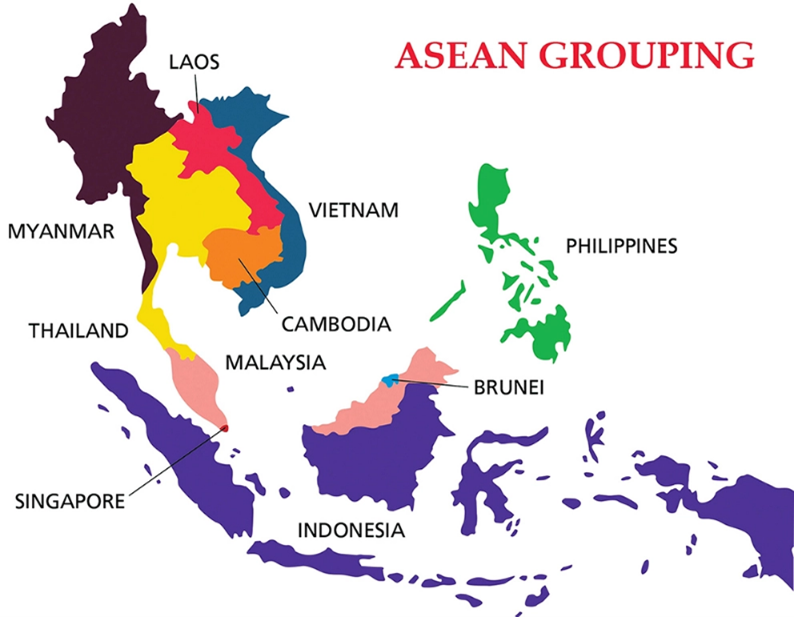
What is the Significance of ASEAN for India?
- Historical Context and Elevation of Partnership:
- 1992: India became a Sectoral Dialogue Partner with ASEAN, marking the beginning of formal engagement.
- 1995: The partnership was elevated to a Dialogue Partner, enhancing interactions to the Foreign Minister level.
- 2002: The relationship was further upgraded to Summit level with the first Summit held in 2002.
- 2012: At the 20-year Commemorative Summit in New Delhi, the Dialogue Partnership was upgraded to a Strategic Partnership.
- 2018: During the 25-year Commemorative Summit, India and ASEAN focused on maritime cooperation.
- 2022: The 30-year anniversary of ASEAN-India relations was celebrated as ASEAN-India Friendship Year, culminating in the elevation of the Strategic Partnership to a Comprehensive Strategic Partnership.
- Economic Powerhouse - Gateway to Southeast Asian Markets:
- ASEAN provides India access to a market of over 650 million people with a combined GDP of USD 3.2 trillion.
- The ASEAN-India Free Trade Area has increased bilateral trade to USD 110.39 billion in 2021-2022.
- ASEAN accounts for 11% of India's global trade, with Singapore being India's largest trade partner in ASEAN and 6th largest globally, also the largest source of FDI valued at USD 11.77 billion in the last financial year.
- Strategic Counterbalance:
- Amid rising geopolitical tensions, especially with China, ASEAN is a crucial strategic partner for India.
- India's 'Act East Policy' aligns with ASEAN's 'Outlook on the Indo-Pacific,' promoting regional stability.
- The elevation to a Comprehensive Strategic Partnership in 2022 highlights this alignment.
- Engagement in forums like the East Asia Summit and ASEAN Regional Forum allows India to assert its role as a net security provider and counter Chinese influence.
- Connectivity Catalyst:
- ASEAN plays a pivotal role in India’s vision of enhanced regional connectivity.
- Projects like the India-Myanmar-Thailand Trilateral Highway and the Kaladan Multi-Modal Transit Transport Project underscore India's commitment, despite delays.
- Digital connectivity, including 5G and cybersecurity, strengthens links and represents strategic investments comparable to China's Belt and Road Initiative.
- Cultural Confluence:
- The historical and cultural ties between India and Southeast Asia offer a foundation for soft power diplomacy.
- Initiatives such as the ASEAN-India Artists' Camp and Music Festival celebrate this shared heritage.
- The ASEAN-India Network of Universities, established in 2022, further enhances academic and cultural exchanges, crucial for public diplomacy and influence in the region.
- Technological Synergy:
- ASEAN’s rapidly digitalizing economies present opportunities for India’s IT sector and start-ups.
- The ASEAN-India Start-up Festival highlights collaboration in fintech, e-commerce, and AI.
- The ASEAN-India Science and Technology Development Fund, with a recent USD 5 million boost, supports joint research in advanced fields.
- Maritime Security Collaboration:
- ASEAN is key to India’s maritime security strategy, particularly in the Indo-Pacific region.
- Collaboration on piracy, illegal fishing, and disaster management through forums like the ASEAN Regional Forum and Expanded ASEAN Maritime Forum aligns with India's SAGAR (Security and Growth for All in the Region) doctrine.
- The inaugural ASEAN-India Maritime Exercise was held in the South China Sea in May 2023.
- Energy Security and Sustainability:
- ASEAN’s energy-rich members offer India opportunities to diversify its energy sources, vital for its growing economy.
- India's expertise in renewable energy, particularly solar power, complements ASEAN's sustainability goals.
- The recent ASEAN-India High-Level Conference on Renewable Energy exemplifies this synergy, with cooperation in semiconductors, clean energy technologies, and sustainable practices.
- Supply Chain Resilience:
- Post-COVID, ASEAN has become a key partner in India’s efforts to build resilient supply chains.
- The pandemic revealed vulnerabilities in global supply networks, prompting a re-evaluation of dependence on single sources.
- Cooperation in sectors like pharmaceuticals, electronics, and automobiles supports diversified and robust supply chains, aligning with broader initiatives like the Supply Chain Resilience Initiative (SCRI) involving India, Japan, and Australia.
Key Concerns in India-ASEAN Relations:
- Trade Imbalance:
- India’s trade deficit with ASEAN has more than doubled since the Free Trade Agreement (FTA) implementation in 2010.
- The deficit is notably high in the electronics and machinery sectors.
- In FY 2022-2023, India's exports to ASEAN were USD 44.04 billion, while imports reached USD 87.58 billion.
- Infrastructure Connectivity:
- Despite advancements in digital and cultural connectivity, physical infrastructure links remain underdeveloped.
- The India-Myanmar-Thailand Trilateral Highway has faced significant delays, and the Kaladan Multi-Modal Transit Transport Project has encountered challenges.
- These delays impede trade flows and people-to-people connections.
- Geopolitical Balancing - Navigating the China Factor:
- China’s growing influence in Southeast Asia challenges India-ASEAN relations.
- ASEAN members are balancing Chinese economic inducements with security concerns.
- India’s role as a counterbalance to China, through initiatives like the Quad Alliance, faces mixed responses from ASEAN countries.
- The South China Sea dispute complicates this dynamic, with countries like Vietnam and the Philippines welcoming India's active role, while others are more cautious.
- Regulatory Hurdles:
- Divergent regulatory standards between India and ASEAN countries create non-tariff barriers to trade and investment.
- Differences in food safety standards and certification processes hinder agricultural trade.
- Lack of mutual recognition agreements in professional services limits the movement of skilled professionals.
Why India Continues to Face a Trade Deficit with ASEAN
- Tariff Asymmetry:
- The ASEAN-India Free Trade Agreement (AIFTA) features asymmetric tariff reductions, disadvantages in India.
- India has reduced tariffs on about 74% of its tariff lines for ASEAN, while ASEAN has reciprocated on only 56%.
- This imbalance, particularly in agriculture and textiles, has contributed to a trade deficit, which reached USD 25.76 billion in 2021-22.
- Non-Tariff Barriers:
- ASEAN countries impose non-tariff barriers (NTBs) that hinder Indian exports.
- Examples include complex regulatory requirements, stringent sanitary and phytosanitary measures, and technical barriers.
- Indian pharmaceutical exports face costly registration processes, and agricultural products often struggle with food safety standards.
- Manufacturing Competitiveness:
- ASEAN countries, such as Vietnam and Thailand, have advanced manufacturing sectors with higher productivity.
- India’s lower labour productivity and higher logistics costs (14% of GDP compared to 5-10% in ASEAN) contribute to competitiveness gaps.
- For example, exports to Vietnam were USD 5.47 billion, while imports amounted to USD 9.34 billion.
- Missing Link in Regional Value Chain:
- India’s limited integration into ASEAN-centric regional value chains worsens the trade imbalance.
- ASEAN countries are key nodes in global supply chains, especially in electronics and automotive sectors.
- India's minimal participation in these networks limits its ability to capture value-added exports to ASEAN and beyond.
- Services Trade Barriers:
- India excels in services, especially IT and ITeS, but faces barriers in ASEAN markets.
- Language barriers, lack of mutual recognition agreements for qualifications, and data localization requirements restrict India's services exports.
- Rules of Origin Exploitation:
- Weak rules of origin in AIFTA allow non-ASEAN countries, particularly China, to route exports to India through ASEAN, worsening the trade deficit.
- This 'trade deflection' inflates the deficit and undermines India’s efforts to reduce dependence on Chinese imports.
Measures to Enhance India-ASEAN Relations
- Recalibrating the ASEAN-India Free Trade Agreement (AIFTA):
- Comprehensive Review: India should advocate for a thorough review of AIFTA to address trade imbalances.
- Balanced Tariff Reductions: Negotiate more equitable tariff reductions, focusing on sectors where India holds a competitive edge, such as pharmaceuticals, textiles, and IT services.
- Phased Reductions: Propose gradual tariff reductions on sensitive agricultural products and seek improved market access for India's services sector.
- Enhancing Infrastructure Connectivity:
- Accelerate Key Projects: Speed up completion of major projects like the India-Myanmar-Thailand Trilateral Highway and extend it to Cambodia, Laos, and Vietnam.
- Connectivity Master Plan: Propose a comprehensive plan aligned with ASEAN’s Connectivity Master Plan 2025, including digital connectivity initiatives like the India-ASEAN submarine cable project.
- Boost Trade: Timely project completion could potentially increase India-ASEAN trade by 20-30% in the medium term.
- Boosting Manufacturing Competitiveness:
- Sector-Specific Interventions: Focus on specific sectors where India's competitiveness can be enhanced.
- Expand PLI Scheme: Extend the Production Linked Incentive (PLI) scheme to more industries relevant to ASEAN trade.
- Joint Manufacturing Initiatives: Develop joint manufacturing projects, such as an India-Vietnam electronics hub, leveraging strengths in software and hardware.
- Enhancing Energy Cooperation:
- ASEAN-India Energy Partnership: Propose a partnership focusing on energy security, clean energy transition, and technology cooperation.
- Joint Research: Initiate joint research on renewable technologies, green hydrogen, and energy storage to support sustainable development goals.
- Enhancing Strategic and Defense Cooperation:
- Maritime Security: Deepen strategic engagement with ASEAN in maritime security.
- Capacity Building: Offer increased assistance in maritime domain awareness, anti-piracy, and humanitarian relief.
- Defence Production: Consider joint defence production initiatives with advanced ASEAN countries like Singapore and Indonesia.
- Aligning on Climate Change and Sustainability:
- ASEAN-India Green Partnership: Propose a partnership focusing on climate change mitigation and sustainable development.
- Technology Transfer: Transfer technologies in solar energy and conduct joint research on climate-resilient agriculture.
Conclusion
India’s engagement with ASEAN, particularly through its partnership with Singapore, reflects a significant shift towards deeper economic, technological, and security collaborations. By addressing trade imbalances and expanding cooperation in strategic sectors, India can maximise the benefits of its evolving relationship with ASEAN.
|
UPSC Civil Services Examination, Previous Year Questions (PYQs) Prelims Q1. India is a member of which among the following? (2015)
Select the correct answer using the code given below:
Ans: (b)
Q2. Consider the following countries: (2018)
Which of the above are among the ‘free-trade partners’ of ASEAN?
Ans: (c)
Q3. The term ‘Regional Comprehensive Economic Partnership’ often appears in the news in the context of the affairs of a group of countries known as (2016)
Ans: (b)
Q4. In the Mekong-Ganga Cooperation, an initiative of six countries, which of the following is/are not a participant/ participant? (2015)
Select the correct answer using the code given below:
Ans: (c)
Mains Q:1 Evaluate the economic and strategic dimensions of India’s Look East Policy in the context of the post-Cold War international scenario. (2016) |
Share the article
Edukemy’s Current Affairs Quiz is published with multiple choice questions for UPSC exams
MCQ
Get Latest Updates on Offers, Event dates, and free Mentorship sessions.

Get in touch with our Expert Academic Counsellors 👋
FAQs
UPSC Daily Current Affairs focuses on learning current events on a daily basis. An aspirant needs to study regular and updated information about current events, news, and relevant topics that are important for UPSC aspirants. It covers national and international affairs, government policies, socio-economic issues, science and technology advancements, and more.
UPSC Daily Current Affairs provides aspirants with a concise and comprehensive overview of the latest happenings and developments across various fields. It helps aspirants stay updated with current affairs and provides them with valuable insights and analysis, which are essential for answering questions in the UPSC examinations. It enhances their knowledge, analytical skills, and ability to connect current affairs with the UPSC syllabus.
UPSC Daily Current Affairs covers a wide range of topics, including politics, economics, science and technology, environment, social issues, governance, international relations, and more. It offers news summaries, in-depth analyses, editorials, opinion pieces, and relevant study materials. It also provides practice questions and quizzes to help aspirants test their understanding of current affairs.
Edukemy's UPSC Daily Current Affairs can be accessed through:
- UPSC Daily Current Affairs can be accessed through Current Affairs tab at the top of the Main Page of Edukemy.
- Edukemy Mobile app: The Daily Current Affairs can also be access through Edukemy Mobile App.
- Social media: Follow Edukemy’s official social media accounts or pages that provide UPSC Daily Current Affairs updates, including Facebook, Twitter, or Telegram channels.

